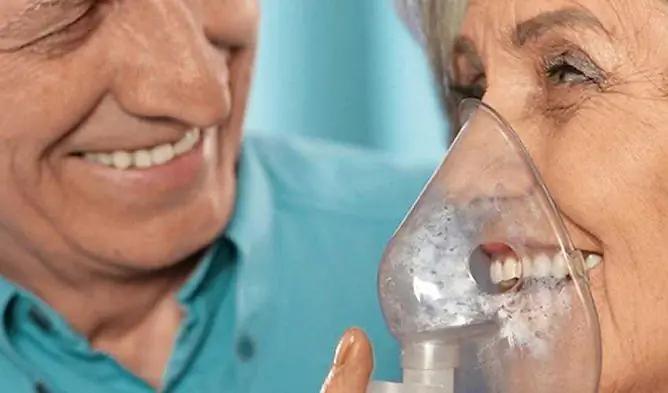- Author Rachel Wainwright [email protected].
- Public 2023-12-15 07:39.
- Last modified 2025-11-02 20:14.
Pulmozyme
Pulmozyme: instructions for use and reviews
- 1. Release form and composition
- 2. Pharmacological properties
- 3. Indications for use
- 4. Contraindications
- 5. Method of application and dosage
- 6. Side effects
- 7. Overdose
- 8. Special instructions
- 9. Application during pregnancy and lactation
- 10. Use in childhood
- 11. Drug interactions
- 12. Analogs
- 13. Terms and conditions of storage
- 14. Terms of dispensing from pharmacies
- 15. Reviews
- 16. Price in pharmacies
Latin name: Pulmozyme
ATX code: R05CB13
Active ingredient: dornase alfa (Dornase alfa)
Manufacturer: F. Hoffmann-La Roche Ltd. (F. Hoffmann-La Roche, Ltd.) (Switzerland)
Description and photo update: 2019-09-07

Pulmozyme is a mucolytic drug used for cystic fibrosis.
Release form and composition
The drug is produced in the form of a solution for inhalation: a colorless or slightly yellowish transparent solution (2.5 ml each in a colorless plastic ampoule, 6 ampoules in a protective container made of multilayer aluminum foil, 1 protective container in a cardboard box and instructions for using Pulmozyme).
2.5 ml solution for inhalation (1 ampoule) contains:
- active substance: dornase alpha * - 2.5 mg;
- additional components: calcium chloride dihydrate, sodium chloride, water for injection.
* 1 mg of dornase alpha corresponds to 1000 Units of action (U).
Pharmacological properties
Pharmacodynamics
Dornase alpha (deoxyribonuclease), a recombinant human DNase, is a genetically engineered version of a human natural enzyme that cleaves extracellular deoxyribonucleic acid (DNA).
The accumulation of viscous purulent secretion in the respiratory tract has a noticeable effect on the dysfunction of external respiration and in the course of exacerbations of the infectious process in patients with cystic fibrosis. In the purulent secretion, a very high content of extracellular DNA is found - a viscous polyanion, which is released from decaying leukocytes that accumulate in response to infection.
In in vitro studies, dornase alpha hydrolyzes DNA in sputum and significantly reduces the viscosity of secreted secretions against the background of cystic fibrosis.
Pharmacokinetics
Systemic absorption of the mucolytic agent after inhalation is negligible. Normally, natural DN-ase is found in human serum. When inhalations of the active substance were carried out for 6 days at doses not exceeding 40 mg, there was no significant increase in the serum concentration of DNase in the blood when compared with normal endogenous levels. The serum DNase content did not exceed 10 ng / ml.
After using Pulmozyme 2 times a day, 2.5 mg (2500 U) for 24 weeks, the mean serum levels of DNase did not differ from the mean values before the start of therapy, equal to 3.5 ± 0.1 ng / ml, which is evidence low systemic absorption and / or slight cumulation. The average concentration of the active substance in patients with cystic fibrosis 15 minutes after inhalation at a dose of 2.5 mg is approximately 3 μg / ml. Then the concentration of the agent in the blood serum decreases rapidly.
It is assumed that the metabolic transformation of Pulmozyme is carried out by the action of proteases present in biological fluids.
After intravenous (iv) injection of dornase alfa, the serum half-life (T 1/2) is 3-4 hours. Within 2 hours, the content of DN-ase in sputum is reduced by more than 2 times compared to that observed immediately after inhalation, while the effect on sputum rheology is observed for over 12 hours.
Indications for use
Solution for inhalation Pulmozyme is recommended for symptomatic treatment in combination with standard therapy for cystic fibrosis in patients with forced vital capacity (FVC) of at least 40% of the norm.
The drug can also be used to treat patients with chronic lung diseases such as chronic pneumonia, chronic obstructive pulmonary disease (COPD), bronchiectasis, congenital malformation of the lungs in children, immunodeficiency states that occur with lung damage, in the case when a physician's assessment of the mucolytic effect of dornase alfa provides benefits to patients
Contraindications
The use of Pulmozyme is contraindicated in the presence of hypersensitivity to any of its components.
The drug should be used with caution in children under 5 years of age, as well as during pregnancy and lactation.
Pulmozyme, instructions for use: method and dosage
Pulmozyme is used by inhalation.
The solution contained in 1 ampoule is intended for single inhalation administration only.
The therapeutic dose is 2.5 mg of deoxyribonuclease (which corresponds to 2.5 ml of an undiluted solution, 2500 U - the contents of 1 ampoule), used without dilution by inhalation 1 time per day using a jet nebulizer.
In some patients over the age of 21, the use of the drug may be more effective with the introduction of a daily dose 2 times a day. In the overwhelming majority of patients, it is possible to achieve the optimal effect of treatment with constant daily use of Pulmozyme. Studies in which dornase alfa was used intermittently showed no improvement in lung function after the end of therapy. Therefore, patients are advised to use the drug daily without interruption.
Against the background of mucolytic treatment, it is required to continue complex therapy, including chest physiotherapy.
In the event of an exacerbation of the respiratory tract infection during inhalation of Pulmozyme, the use of the latter can be continued without any risk of worsening the patient's condition.
Before inhalation, the solution contained in 1 ampoule must be poured into a container of a jet nebulizer (compressor) such as Hudson T Up-draft II / Pulmo-Aide, Airlife Misty / Pulmo-Aide, modifications Respigard / Pulmo-Aide or Acorn II / Pulmo -Aide. Pulmozyme can be administered using a reusable jet nebulizer (compressor) such as Pari LL / Inhalierboy, Pari LC / Inhalierboy or Master, Aiolos / 2 Aiolos, Side Stream / CR50, Mobil Air or Porta-Neb.
If the patient cannot breathe through the mouth during the entire period of inhalation of the agent through a nebulizer, a Pari Baby device with a mask tightly fitting to the face can be used.
It is necessary to strictly follow the instructions of the manufacturer for the operation and care of the nebulizer and compressor.
Side effects
Undesirable effects on the part of systems and organs registered during therapy with Pulmozyme [occurred rarely (less than 1/1000), as a rule, were mild, were temporary and did not require dose changes]:
- respiratory system, chest and mediastinal organs: cough (including productive cough), increased bronchial secretions, alveolitis, rhinitis, pharyngitis, voice changes (hoarseness), laryngitis, shortness of breath, respiratory tract infections (including those excited by Pseudomonas), bronchitis, pneumonia, laryngeal polyp, deterioration of lung function, respiratory failure, pneumothorax, hemoptysis, pulmonary hemorrhage, bronchospasm, hypoxia;
- nervous system: migraine, epileptic seizures;
- hematopoietic system: aplastic anemia, acute lymphocytic leukemia;
- cardiovascular system: bradycardia, tachycardia, cardiac arrest;
- sense organs: imbalance, conjunctivitis;
- digestive system: abdominal pain, dyspepsia, liver failure, bloody vomiting;
- reproductive system: complications of pregnancy, premature birth, medical abortion, spontaneous abortion;
- dermatological reactions: itching, rash, urticaria, dermatitis, purpura, angioedema;
- laboratory and instrumental studies: decrease in respiratory function indicators;
- general disorders: malaise, weakness, chest pain (pleural / noncardiogenic), fever, pyrexia, death.
In cases where there were undesirable effects similar to the symptoms of cystic fibrosis, further use of Pulmozyme was usually allowed. Adverse reactions that led to complete withdrawal of drug therapy were observed in a small number of patients, and the frequency of treatment interruptions was the same with both placebo (2%) and dornase alfa (3%). Antibodies to the latter were detected in less than 5% of patients, but in none of these individuals they belonged to the class of immunoglobulins E (IgE). An improvement in lung function indicators was recorded even after the detection of antibodies to dornase alpha.
Overdose
No cases of overdose of dornase alfa have been reported.
Single inhalations of Pulmozyme to animals in doses significantly higher than those usually prescribed to humans (almost 180 times) were well tolerated. In clinical studies, patients with cystic fibrosis used the drug by inhalation at a dose of 20 mg 2 times a day for 6 days and at a dose of 10 mg 2 times a day for 168 days according to an intermittent scheme (2 weeks of treatment after 2 weeks off). During the study, both dosing regimen was well tolerated.
Systemic toxicity of the drug has not been identified and is not expected due to its low degree of absorption and short T 1/2, therefore, in case of an unintentional overdose of Pulmozyme, systemic therapy is not required.
special instructions
During the period of use of a mucolytic agent, patients should be under regular medical supervision.
After starting to use Pulmozyme, like any aerosol, lung function may deteriorate slightly, and sputum production may increase.
The safety and efficacy of dornase alfa use have not been determined in patients with FVC less than 40% of the norm.
A single short-term action (no more than 24 hours) at elevated temperatures - up to 30 ° C, does not affect the stability of the solution for inhalation use.
Influence on the ability to drive vehicles and complex mechanisms
There are no reports of the effect of Pulmozyme on the patient's ability to drive a car or other potentially dangerous moving machinery.
Application during pregnancy and lactation
The safety of using Pulmozyme inhalation solution during pregnancy has not been established. In animal studies, no teratogenic properties, fertility disorders or negative effects of dornase alfa on fetal development were revealed. During pregnancy, the drug should be prescribed with extreme caution, only in cases where the expected benefit to the woman outweighs the possible risk to the fetus.
It is also necessary to use Pulmozyme during breastfeeding with caution, since it is not known whether dornase alfa is excreted in human milk in humans. Given the minimal systemic absorption of the active ingredient of the drug while adhering to the recommended dosing regimen, measurable levels of the drug in breast milk in women should not be expected. In lactating macaques, which in the course of studies received high doses of dornase alfa, it was found to have low concentrations in breast milk (less than 0.1% of serum levels).
Pediatric use
In the course of clinical trials, Pulmozyme was used in children aged 3 months to 9 years old with cystic fibrosis, in the form of inhalations 1 time per day at a dose of 2.5 mg for 2 weeks. Within 90 minutes after the introduction of the first inhalation dose, bronchoalveolar lavage (BAL) was performed. In the BAL fluid solution, the concentration of DNase in all patients reached a detectable level, but varied significantly - from 0.007 to 1.8 μg / ml. After using the drug for about 14 days, the serum concentration of DNase in the blood (mean ± standard deviation) increased in children aged 3 months to 5 years and from 5 to 9 years by 1.1 ± 1, 6 and 0, 8 ± 1.2 ng / ml, respectively. The relationship between the level of DNase in BAL fluid or serum with the occurrence of undesirable conditions or the effectiveness of treatment has not been determined.
The reported side effects were similar to those noted in other studies in children. In the group of children from 3 months to 5 years, compared with older patients, cough was most often observed (as an undesirable effect), including in severe / moderate severity, as well as rhinitis and rash. The experience of using Pulmozyme in children under 5 years of age is limited, and the effectiveness of therapy has not been studied. Prescribing the drug to patients in this age group is allowed only if the expected improvement in lung function outweighs the risk of infection.
Drug interactions
Pulmozyme is compatible with such standard drugs / drugs for the treatment of cystic fibrosis as bronchodilators, antibiotics, digestive enzymes, inhalation and systemic glucocorticosteroids (GCS), analgesics, vitamins.
Pulmozyme is an aqueous solution without buffering properties. The drug must not be diluted or mixed with other drugs or solutions in the nebulizer container, since such mixing may cause undesirable structural and / or functional changes in Pulmozyme or another ingredient in the mixture.
Analogs
Pulmozyme analogs are Ambrobene, Lazolvan, Orvis Broncho, ACC, Bromhexin, Bronkhoval, AcetylCysteine, Fluditec, Halixol, etc.
Terms and conditions of storage
Store in a place protected from light, at a temperature of 2-8 ° C.
Shelf life is 2 years.
Terms of dispensing from pharmacies
Dispensed by prescription.
Reviews about Pulmozyme
In most cases, patients leave positive reviews about Pulmozyme. They note its high efficiency when used as a means of symptomatic therapy for cystic fibrosis and chronic lung diseases. When using mucolytic, the viscosity of sputum is significantly reduced, the drug contributes to its normal discharge, improving lung function. In many patients, after regular inhalations, shortness of breath disappeared, and cough decreased significantly. However, patients note that Pulmozyme should be used only as directed and under medical supervision.
The disadvantages of Pulmozyme are its high cost and the presence of side effects.
Price for Pulmozyme in pharmacies
The price of Pulmozyme, a solution for inhalation (2.5 mg / 2.5 ml) can be 1500-6500 rubles. per package containing 6 ampoules of 2.5 ml.

Maria Kulkes Medical journalist About the author
Education: First Moscow State Medical University named after I. M. Sechenov, specialty "General Medicine".
Information about the drug is generalized, provided for informational purposes only and does not replace the official instructions. Self-medication is hazardous to health!






